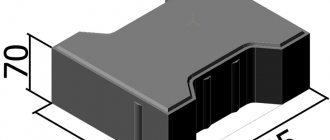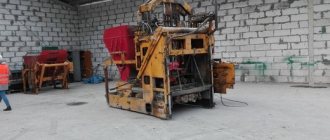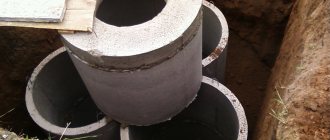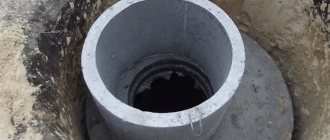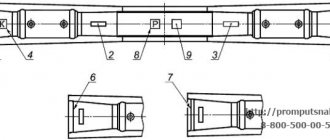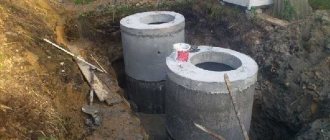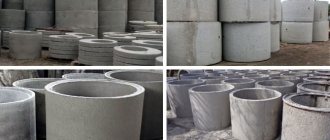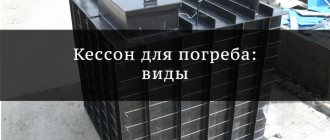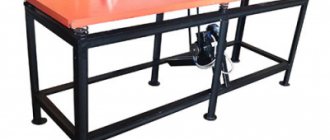Produced in accordance with GOST 8020-90. Reinforced concrete products (well rings).
Well rings are used for installation of inspection, drainage, and sewer wells. The rings are made of concrete grade M200. Reinforcement with a diameter from 0.6 to 10 mm. Reinforced concrete rings come in 3 main sizes; KS-10-9 (diameter 1 meter, height 90 cm), KS-15-9 (diameter 1.5 meters, height 90 cm), KS-20-9 (diameter 2 meters, height 90 cm).
The main advantage of the technology we offer is the simplicity of production operations, which make it possible to obtain well rings with an ideal front surface. To organize production, the following equipment is required: a forced-action concrete mixer, a mold for the production of well rings and a lifting device, such as a beam crane, equipped with an electric or manual lifting mechanism. Also in production, a pre-prepared ready-made reinforced frame is used, which can be made independently.
For production, you will need a flat platform on which finished products will be molded and stood. The formwork is equipped with two vibrating electric motors of 1.5 kW, 3000 rpm. Locks on reinforced concrete rings of wells. Such rings are mainly marked KS 10-9. You can use materials of other standard sizes, the main thing is that they have interlocking folds and the same geometric dimensions. Although the shapes of the connecting ends may vary. Rings with a “lock” provide better tightness and water tightness of connections, and also protect the well shaft from horizontal displacements. Lock rings are usually more expensive than regular rings. Russia, Kirov (region) tel (in Moscow) + 7 (926) 246-57-54 (Ekaterina Vinogradova)
What do you need first?
My friend, who has been producing reinforced concrete rings for 10 years, advises first of all to study the sales market. And after you have determined which organizations you will have to compete with, you can begin to implement your plans. My friend says that large factories, as a rule, will not pose serious competition to individual entrepreneurs in the production of reinforced concrete rings. Factory prices are usually significantly higher than those of individual entrepreneurs, which means that it is the well-organized production of well rings by an entrepreneur that will capture the majority of the market. Competition for your production will only come from the same individual entrepreneurs as you, as well as bases for the sale of ready-made concrete, where usually, after the end of the shift, there is unsold concrete, which is subsequently used for the manufacture of well rings, the bottom of the well and their covers.
If, after analyzing the market, conditions and competition are low in your region, then you can begin organizing your own mini-factory.
What is needed for this? The most important thing is the location, then the purchase of equipment and consumables, and of course you cannot cope alone without labor.
Ring production area
To choose a place for the production of reinforced concrete rings, you need to consider two options:
The requirements for both the first and second options are good access roads and access to electricity and water.
The main advantage of organizing production in the open air is low rent, and if you own this site, then no rent at all. The downside will be the dependence on weather conditions and the shutdown of production in winter.
The main advantage of organizing a mini-factory indoors is year-round production, but the disadvantage is high rent.
Equipment
The production of reinforced concrete rings, covers and bottoms does not require high-tech and expensive equipment. So the main equipment for the production of reinforced concrete rings is molds for reinforced concrete rings. I apologize for the tautology, but of course we cannot do without a concrete mixer, several shovels of a trowel and a couple of buckets.
To begin with, you can search the Internet and buy used equipment or even rent it in the future, of course, when you get into the black, it is advisable to purchase everything new.
Undoubtedly, one of the most important components of the equipment are the molds for making rings, lids and bottoms. To begin with, you can try to order them from a handicraft workshop or directly from high-quality factory ones. The price of molds of common sizes 1×0.9m, 1.5×0.9m and 2×0.9m will be about 40, 60 and 80 thousand rubles, respectively. In addition, you will need molds to produce the caps and bottoms for each ring size. Their price will vary between 10, 12 and 15 thousand rubles, respectively. To begin with, you will need one of these shapes for each ring size.
In addition to the forms, you need to think about how you will lift the finished products from the site and then load them into vehicles, as well as for removing the forms. The most common equipment in this case is a beam crane or loader, which can perform the same functions, but the best option would be a loader crane. With it, you can also organize the delivery and installation of products. In bad weather, when there is slight frost, you will need a heat gun to reduce the waiting time for concrete to set.
The figure shows you all the common sizes of cap and bottom rings. In the future, you will be able to expand the range by making additional rings - these are rings with a height of 0.3 m and 0.6 m.
Consumables
To make a reinforced concrete ring you will need concrete grade M-200. For example, to make rings KS-10.9 (1 m in diameter along the inner wall) you need 0.3 cubic meters of concrete, KS-15.9 (1.5 m in diameter) - 0.45 cubic meters of concrete.
Explanation of the abbreviation KS 10-9 - KS is a wall ring, 10 is its diameter, 9 is its height. PN 10 – PN is a bottom plate, 10 in diameter. PP 10-1 – PP is the floor slab, 10 is the diameter, 1 is the load class.
But concrete is not all you need; for the production of rings, road (welded) mesh with cells no larger than 15*15 cm is also used. The frame of the product is built from it, in much the same way as the frame of a building is built from reinforcement. To make mounting hooks, you will need reinforcement with diameters from 6 to 10 mm, and in order for the products to have a beautiful appearance, plastic film is adjusted to the molds and treated with a special compound called “Emulsol”.
Production and sales
The production of rings is carried out in two variations:
- standard product with a flat end side,
- with locking fastenings and special ends (characterized by increased waterproofing resistance).
In the process of installing reinforced concrete products at the site of their use, it is important to strictly comply with construction requirements, and the most important of them is to ensure maximum tightness of the connections. In rings where there are no special locks, the function of the sealant is taken over by metal staples and concrete mortar. The elements are placed in a pre-prepared trench, which is buried after completion of the work.
You can order the production of products from our company. We use our own equipment and materials, which allows us to achieve high quality at an affordable cost.
The scope of application of reinforced concrete rings is quite extensive. If you need to save money, you can make them yourself. But this requires forms for concrete rings. Buying such equipment is an expensive pleasure; for private use it will not justify itself. But you can also make the forms yourself.
What are concrete rings for?
Most often, concrete rings are needed for the device, but they are also used when installing an autonomous sewer system - or making filtration wells. Another area of application is inspection wells when constructing a drainage system. They are even made from concrete rings. Moreover, there are different options - vertical, horizontal. In general, the scope of application is wide.
There are rings of different sizes to suit different needs, they also have different wall thicknesses, and can be with or without reinforcement. Despite such an abundance of choice, many people think about making reinforced concrete rings with their own hands. The thing is that when arranging a site you may need more than one ring, or even ten. Some people spend more than a dozen just on a well. The cost of manufacturing reinforced concrete products is much lower than their retail price. Even taking into account the fact that you will have to make molds for concrete rings. And if you also take into account the cost of delivery, the savings turn out to be very significant.
Concrete rings, is it possible to make them yourself?
It’s hard to imagine a country farm without a well. Indeed, life in a summer cottage becomes much easier if you have your own well in the yard. Concrete rings are used in the construction of the well. In addition, concrete rings are used for sewerage. Therefore, the site Beton-Area.com will tell you about these products and provide their exact sizes and prices.
Concrete rings
Before we talk about the use of concrete rings, we need to talk about their technical characteristics. In addition, their advantages and disadvantages need to be mentioned.
So, concrete rings are a strong and durable building material. This is considered the main advantage of concrete rings. It is worth saying that concrete rings are made only from high-quality cement. The cement used to make concrete rings is not used for interior finishing work. In addition to high-quality cement, the following is added to the solution for pouring concrete rings: fine crushed stone, water and sand.
Concrete rings have a number of advantages. It is necessary to list them now. Concrete rings differ:
- Quick installation. Indeed, such material is installed several times faster. However, during installation, lifting equipment is used.
- Favorable price.
- Convenient installation with a tight fit and mating of the rings with the locks without gaps.
- Monolithic structures. When installing concrete rings, you will not have to use ropes and cables for additional fixation.
- Long service life. With proper waterproofing, the service life of such products can be 50 years.
Now it is important to mention some of the disadvantages of concrete rings. So, such products are characterized by:
- Difficult installation. Proper installation of the rings will require special equipment and additional labor.
- Difficulties in transportation.
In addition, the disadvantages include the fact that the rings can crumble. This usually happens due to the fact that professional technologies were not followed in production. Products can also deteriorate if they are not properly cared for and have poor quality waterproofing. Great attention must be paid to waterproofing the rings. After all, if this point is not carried out properly, the fittings that are built inside the products may deteriorate.
Where are concrete rings used?
Concrete rings are widely used. These products are mainly used for the construction of industrial wells and sewerage systems. In addition, such products are used to construct drinking water wells.
It is worth noting that concrete rings can be laid on absolutely any soil. Thanks to the special connection of the rings with each other, a solid and waterproof structure is formed that is not afraid of soil movement and other similar phenomena.
Now is the time to report the dimensions of such products. So, concrete rings can have completely different parameters. However, products are selected according to the size of the sewerage project. In addition, when choosing a size, the purpose of the well is taken into account. For example, for a manhole, rings with a diameter of 30 cm wide are suitable. In general, you can choose the size of concrete rings only if you pay attention to studying special tables.
To install an autonomous sewer system outside the city or in a summer cottage, concrete rings of standard sizes are used, which are provided for by GOST. The picture shows the popular sizes of concrete rings that are used to install sewer wells.
To equip some wells you need a bottom. This element also has its own standard sizes. The bottom is capable of supporting the entire assembled structure. This product is made from high strength concrete. In addition, such an element has a reinforcing mesh. It must be said that in modern markets you can immediately purchase concrete rings with a finished bottom. Complete with concrete rings there is a special hatch that covers the structure and protects it from dirt and precipitation. The special ceiling is equipped with a hole, which is necessary for servicing the well.
To purchase high-quality rings and individual elements for them, you need to calculate their sizes in advance. If you don't do this, you could be wasting serious money. Moreover, labor-intensive transportation of parts will cause unnecessary trouble.
DIY concrete rings
There is no need to describe for a long time all the advantages of concrete rings. These products really cannot be replaced with other modern materials. Now it’s worth talking about how to make concrete rings with your own hands. You can also watch a professional video on this topic.
So, first of all, to make rings you will need fresh 400 grade cement. It is also worth using quartz sand. However, before use, the sand is washed with plain water, thus removing excess impurities from it. The third component will be fine gravel of a plastic form. To make a concrete ring, you must use steel reinforcement with a diameter of 6 or 8 mm.
Progress of work on creating a concrete ring
- First you need to build a wooden formwork. To do this, you need to knock together two rings of wood for the outer cylinder, then you need to make two rings for the inner cylinder. The sides of the form are made of roofing sheets or boards. The formwork must consist of several parts and be collapsible. The walls of the form must be fastened with wooden planks.
- Then the surfaces of the cylinder that will be filled with cement composition are lubricated with machine oil. Then a large diameter cylinder is installed on a wooden board. The structure is being strengthened. Then the inner cylinder is inserted strictly in the center of the outer cylinder.
- Now it’s time to insert the reinforcement lugs into the gap between the cylinder walls. To hold the reinforcement in the desired position, you need to place 4 wedges.
- After this, a cement solution is prepared in the following proportions: 1 part cement, 2-3 parts sand, gravel, 4-5 parts crushed stone.
- The finished cement composition must be placed in the gap between the cylinders to a height of about 100 mm. The solution must be compacted using a metal pin. After which the wedges are moved to a height of 200 mm. This is done in order to fill them with concrete. Now, using the tapping method, you need to fill out the entire form. Work must be stopped for 4 days. After this time has passed, the resulting concrete ring must be freed from the formwork.
- Now the product must be left on the wooden board for another four days. It is important to water the product periodically. Water will allow the concrete ring to become stronger. The finished product must be cleaned of machine oil and used for its intended purpose.
As you can see, making concrete rings with your own hands is a serious and labor-intensive process that should be approached with great responsibility. But if you do everything correctly, you can get a quality product and save your money.
Types and sizes of concrete rings for wells
Industrially manufactured concrete and reinforced concrete rings must meet the standards prescribed in GOST 8020-90. Their dimensions can be taken from the table, as well as the approximate weight and price (indicated including delivery in Moscow).
| Name | Height | Wall thickness | Inner diameter | Weight | Price without lock/with lock |
| KS-6 | 7 cm | 12 cm | 58 cm | 60 kg | 390 rub. |
| KS-7-1 | 10 cm | 8 cm | 70 cm | 46 kg | RUR 339 |
| KS-7-1.5 | 15 cm | 8 cm | 70 cm | 68 kg | 349 RUR |
| KS-7-3 | 35 cm | 8 cm | 70 cm | 140 kg | 589 RUR |
| KS-7-5 | 50 cm | 8 cm | 70 cm | 230 kg | 800 rub |
| KS-7-6 | 60 cm | 10 cm | 70 cm | 250 kg | 830 rub. |
| KS-7-9 | 90 cm | 8 cm | 70 cm | 410 kg | 1230 rub. |
| KS-7-10 | 100 cm | 8 cm | 70 cm | 457 kg | 1280 RUR |
| KS-10-5 | 50 cm | 8 cm | 100 cm | 320 kg | 1110 rub. |
| KS-10-6 | 60 cm | 8 cm | 100 cm | 340 kg | 1130 rub. |
| KS-10-9 | 90 cm | 8 cm | 100 cm | 640 kg | 1530 rub / 1700 rub |
| KS-12-10 | 100 cm | 8 cm | 120 cm | 1050 kg | 2120 rub. |
| KS-15-6 | 60 cm | 9 cm | 150 cm | 900 kg | 2060 rub. |
| KS-15-9 | 90 cm | 9 cm | 150 cm | 1350 kg | 2670 RUR |
| KS-20-6 | 60 cm | 10 cm | 200 cm | 1550 kg | 3350 rub. |
| KS-20-9 | 90 cm | 10 cm | 200 cm | 2300 kg | 4010 rub. |
| KS-25-9 | 90 cm | 12 cm | 250 cm | 2200 kg | 16100 rub. |
To manufacture products of each type, there must be two parts of the formwork - external and internal. The distance between them is specified in GOST and depends on the size of the ring. For reinforced rings for a well with a diameter of 70 cm or 100 cm, this is 7 cm and 8 cm, respectively; when making rings without laying reinforcement, the wall thickness is much greater - 12 cm and 14 cm.
For the manufacture of reinforced concrete rings, special molds are required
In addition to different sizes, there is also a different profile of the end part of the rings - smooth and with a lock. A lock is a tongue-and-groove protrusion. Such rings are called tongue-and-groove or locking rings. When placed on top of each other, they adhere well and are difficult to move under lateral loads, which is very important when constructing wells for any purpose. The disadvantage of this option is that the shapes for concrete rings are more complex - it is necessary to form appropriate steps at the ends.
Subtleties of making at home
The construction of a concrete ring is ridiculously simple; it is a concrete casting reinforced with iron from the inside. Attention should be paid to 2 main points: a correctly prepared solution and a well-made mold for casting.
What types of joining grooves are there for concrete rings?
Preparation of the solution
- The quality of the prepared solution plays a big role here, so there is no need to skimp on it. As for cement, as a rule, grade M500 or higher is taken. The rings will be used in extreme conditions and if you use low-grade cement, they will quickly begin to collapse.
Homemade metal mold from 1.5 mm sheet.
- Quartz sand is traditionally used as a filler. But the sand must be clean and washed. A high silt or clay content can significantly reduce the quality of the solution.
- The gravel should not be very rounded and well washed. Also, do not take layered or lamellar grains. As for the sizes, they are selected at the rate of up to ¼ of the thickness of the ring walls. So for a product with a thickness of 100mm, gravel is taken in the range of up to 25mm.
Preparation of concrete from M400 cement.
Important: for this solution, the frost resistance and abrasion coefficients are less important. Here you should pay attention to the shrinkage coefficient. The less concrete shrinks, the denser and stronger it will be. To reduce this coefficient, there are special additives.
Proportions of concrete using M500 cement.
Construction of wooden formwork
- Internal and external formwork can be made of ordinary planed boards and plywood. Planed boards are taken with a thickness of 20 to 50 mm. It is better to take thicker plywood 10 - 12mm.
- The board will make up the body of the drum. It will be attached to knocked down or glued plywood rings.
Pouring concrete rings into wooden forms.
- First, 2 - 3 sheets of plywood are fastened together, the sheets are taken 300 - 400 mm larger than the outer diameter of the ring. Afterwards, a pattern is made from this blank using a jigsaw for the outer and inner contours of the formwork. When making calculations, do not forget to take into account the thickness of the planed board with which the contour will be sheathed.
- There are 2 contours, top and bottom. After this, both contours are sheathed with prepared boards and cut into sectors for ease of dismantling after the structure has hardened.
- Sectors of the external formwork can be fastened with wooden planks or, better yet, metal hoops. From the inside, the formwork is cut into 2 segments and removable strips 20 - 30 mm wide are made at the junction of the segments. After hardening, the removable strips are removed and the segments of the internal contour are pulled out.
Scheme of wooden formwork.
Metal formwork
- This option is easier to manufacture, much more durable, plus the metal does not absorb moisture. But for it you will need 2 metal or plastic barrels or pipes of suitable diameter for the internal and external circuit.
Installing the top clamps on a homemade mold.
- Next, draw 2 vertical lines diagonally on the plane of the outer cylinder. On their border, on the outside, 2 - 3 window awnings need to be fixed, welded or riveted. After which the contour is cut with a grinder according to the markings. But be careful not to damage the awnings.
Ring shape with adjustable diameter.
- The fastening rods of the canopies are also cut off, but only on one side, so that they can be taken out and inserted back.
- The internal contour is made in the same way, only the canopies are attached from the inside of the cylinder. The sizes of the sectors here need to be different, so they will be easier to remove. The smaller sector should be 1/3 of the cylinder diameter.
Metal factory formwork.
Pouring technology
- The instructions on how to fill rings in wooden or metal formwork are similar. Initially, the rings are installed on a flat, durable surface, centered and fixed in their original position.
- It can be fixed with wooden spacers, which are subsequently removed, from the inside in 3 to 4 places. Or use metal threaded studs and nuts. In the holes from the studs, you can then attach metal brackets that fasten 2 adjacent rings. Otherwise, you will need diamond drilling into the concrete to make the connections.
- The reinforcement frame is made from a rod with a cross-section of 6 - 10 mm. There must be at least 4 horizontal reinforcing rings per 1 m height of the structure. Vertical cross members are attached in increments of 100 - 150 mm. If you do not want to reinforce the structure, then in this case the thickness of the ring should be at least 150 mm, plus the concrete should have a high strength coefficient.
- The solution is made with good fluidity. For plasticity, people add slaked lime and a little detergent. But as mentioned earlier, it is better to use special additives that increase the shrinkage of concrete.
- Filling is done around the perimeter in several stages to a height of 150 - 200mm. Before pouring the next portion, the previous fill must be pierced in order to expel the air.
- The top edge is aligned horizontally. If the edge turns out to be crooked, then to level it you will need to cut the reinforced concrete with diamond wheels.
Approximate price for concrete rings.
Important: the formwork can be removed after 3 – 4 days. But the ring cannot be moved yet, the concrete gains strength within 27 days, during which time it must be periodically wetted.
The video in this article shows the making of rings
Manufacturing technology of concrete and reinforced concrete well rings
To make concrete rings in production, a rigid solution with a small amount of water is used; after pouring, it is necessarily subjected to vibration. Without this process, it is impossible to achieve uniformity and high strength. In production, vibrators are built into the walls of molds; in private production, you can use submersible vibrators for concrete. These are relatively small devices, the body of which is held in the hands, and the vibrating head is lowered into the concrete. The length of this nozzle should be sufficient to reach almost to the bottom of the ring.
What concrete to use
Concrete for well rings is used in terms of strength for sooting not lower than B15 (class M200). Composition of rigid concrete used in production:
- cement PC500D0 – 230 kg:
- medium grain sand (fineness modulus 1.5-2.3) - 900 kg;
- crushed stone fraction 5-10 mm - 1100 kg;
- plasticizer S-3 - 1.6 kg;
- water - 120 liters.
The output is a cubic meter of concrete. The amount of water is indicated for sand with a moisture content of 4%. If the sand is wet, the amount of water decreases significantly.
What must be said is that you cannot mix such dry concrete in a regular “pear” type. For kneading, you must use a forced-type mixer. If it is not there, make more fluid concrete. The disadvantage of this solution is that it is necessary to keep the concrete in the formwork for some time (from 4 to 7 days depending on the temperature). If you have one mold for concrete rings, making a dozen concrete rings can take months. The solution is to make the solution as rigid as possible and have more than one pair of formwork.
Reinforcement of concrete rings
You can, according to all the rules, knit a reinforcing ring from a ribbed rod 8-10 mm thick - circles connected to each other by vertical segments of reinforcement. The number of reinforcement rings depends on the height of the ring. The optimal distance between them is 20-30 cm. With a well ring height of 90-100 cm, three or four reinforcement belts are made. Vertical sections are installed in increments of 30-40 cm. They are tied with a special knitting wire.
Loops can be attached to the upper reinforcement belt, using which the concrete ring can be tilted using lifting equipment.
When installing a reinforcing belt, remember one detail: the reinforcement must be located in the thickness of the concrete. There should be at least 3-4 cm from the metal to the edge of the product. Therefore, the figure above shows that the reinforcement belts are not on the surface, but much lower. This is approximately how the fittings should be positioned.
The reinforcement can be welded, but it’s better to tie it together - the structure is more durable
Homemade concrete rings are often reinforced with a ready-made steel mesh - the thickness of the rod is at least 4 mm, the pitch is 20 cm. It is cut to the required height and length, bent into a ring, and the edges are tied with wire. This reinforcement is somewhat worse than the standard one, but is quite sufficient to provide greater strength.
What does vibration give?
The vibration process increases the strength of concrete by several classes (without changing the recipe). When processing concrete, it “sits” before your eyes; air bubbles come out of it, and the aggregate and cement are distributed more evenly. It will not be possible to do without this procedure - the walls will be loose, will leak and quickly collapse.
However, you cannot overdo it - delamination may occur. Stop processing when the shrinkage of the solution stops, the surface becomes smooth and cement laitance appears on top.
Manufacturing process
The outer (external) part of the formwork is installed on a flat platform or sheet of iron. If a tongue-and-groove ring is being made, the groove former is placed down. A reinforcing mesh is placed at a distance of 3-4 cm from the edge of the formwork. The inner part of the formwork is placed and fixed with screws to the protruding parts of the outer formwork (fingers).
Concrete is poured into the established form using shovels or some other device. After the ring is filled, vibration is carried out (in ready-made forms this takes 1-2 minutes). If necessary (look at shrinkage), concrete is added. After the end of vibration, the surface of the ring is smoothed with a trowel. If necessary, install and press the ridge ring.
In industrial conditions, formwork is immediately stripped - this is why hard concrete is used, so that the kit can be immediately used to make the next ring. To do this, remove the fingers and remove the formwork. The void former that forms the bottom groove remains until the concrete sets.
Production of concrete rings
For a process such as the production of concrete rings, the following types of equipment are used: a lifting mechanism in the form of a forklift or crane beam, a concrete mixer, a regular form or a form with vibrating equipment.
Technology for the production of concrete rings
The outer part of the mold is placed on a metal tray or flat surface for pouring. A welded frame, which has a reinforcing nature in the form of a mesh, is lowered into it. During an operation such as the production of concrete rings for a lock, a rubber converter is installed on the lower part of the mold. During the manufacture of concrete rings using technological openings, the installation of specially manufactured opening formers should be used.
After this, the inner part of the formwork is installed, and then the core. The formwork is fixed with metal fingers. Calculation of the quantitative composition of the components necessary for the production of a concrete mixture of the required grade, in a process such as the production of concrete rings, is carried out using a certain table. In this case, it is necessary to take into account the fact that the amount of water is proportional to the moisture content of the sand.
In order to improve the mobility of the concrete mixture, it is necessary to use a special plasticizer. In addition, it is necessary to add plasticizing air-entraining additives to the concrete solution. In this case, hydrophobic additives are acceptable. Using these additives, wall blocks are often made from cellular concrete.
When producing concrete rings in molds equipped with a vibrating device, it is possible to increase the amount of water and crushed stone fraction. The supply of ready-made concrete into the pouring mold, in compliance with the technological standards of such a process as the production of concrete rings, is carried out using a shovel. It is also possible to use simple mechanisms in the form of small belt conveyors.
After filling out the form, the vibrating device is turned on for a couple of minutes. Thanks to the operation of the vibrator, the concrete mixture is compacted. During this process, if necessary, concrete is added to the form. Upon completion of the pouring process, the upper end part of the ring is smoothed and leveled using a trowel.
After all these processes, it is necessary to remove the fingers that strengthen the shape. The liners that form openings in the rings are also removed. Next, using volumetric equipment, you need to remove the core from the mold. Then the outer part of the mold is removed. This part is immediately installed in place of the filling of another product. The entire cycle of operations associated with the manufacture of the next ring is carried out in a similar way. In the process of making rings in molds equipped with vibrators, it is better to have steaming chambers for the finished products.
Since well rings can be of different types, they can be used to install wells for different purposes. Thanks to the special design, which ensures high-quality adhesion of the elements, as well as a variety of diameters, the use of concrete rings is economical and convenient.
Equipment for the production of concrete rings
Equipment necessary for the production of concrete well rings:
— a lifting device in the form of a loader or a beam crane;
— vibroform or simply a mold for concrete rings;
— concrete mixer.
Installation of the outer ring of the vibroform is carried out on a flat surface or a metal tray. A reinforcing frame is placed into the pallet. In the case when the production of concrete rings involves the manufacture of products with a lock, it is necessary to install a rubber lower void former. The inner core is installed and fixed with metal fingers. During the manufacture of rings with openings, it is necessary to install opening formers.
promplace.ru
How and from what to make molds for concrete rings
Factory molds are made of sheet metal and reinforced with stiffeners. Metal thickness is 3-8 mm depending on the dimensions of the ring.
From thick-walled barrels
At home, bending sheet metal with the required radius of curvature is not at all easy. It is much easier to find two thick-walled barrels with different diameters. The diameters should differ by 14-16 mm. In this case, the wall thickness will be 7-8 mm. For a well ring with reinforcement, this is what is required.
The bottom of the barrels is cut off, the inside is made higher by about 10 cm - this is more convenient. To be able to remove the formwork from the finished ring, the barrels are sawn lengthwise into two parts. The halves must be connected securely. You can do this in different ways:
- Having welded the corners with drilled holes, tighten them with bolts;
- make “ears” into which to drive wedges.
To prevent the inner part from leading, several spacers must be welded to each half, which will keep the walls from bending.
Having inserted one part of the formwork into another, they are placed at the same distance from one another (measuring the gap in a circle). Holes are drilled in several places for the studs with which they will be secured. Studs are pieces of rod with threads on both sides. The holes are placed one opposite the other so that parts of the formwork can be securely fixed.
Studs are inserted into the drilled holes and tightened with nuts. If the walls of the mold for concrete rings are not very thick, you will most likely have to place large washers or metal plates with holes cut out of metal under the nuts so that the mold does not bend when pouring concrete.
Sheet metal
If desired, you can make forms for concrete rings from a strip of sheet metal and wooden blocks, which will give rigidity to the formwork. Cut the strip to the required length - along the circumference + 10 cm for the connection. The width of the strip is equal to the height of the ring + 10 cm. Bend the sides 5 cm at the bottom and top, and make the same side along the edge of the strip. Drill holes in the side panel for the tightening bolts. Cut the top side every 20-25 cm (less if the diameter of the ring is small). Now the strip can be bent to create a ring. But it is very unstable - it “plays”. Rigidity can be added using a wooden frame.
Molds for concrete rings can be made from sheet steel
From the bar, cut pieces 20-25 cm long. Attach them under the side, drill a hole in the metal, screw sections of bars onto self-tapping screws. With a length of bars of 20-25 cm, the shape will not be round, but multifaceted. If this is critical for you, you can make cuts more often and cut the bars shorter. The height also needs to be strengthened. Bars are also used for this. They need to be fastened more often so that the walls do not sag.
If you know how to use welding, you can go the other way. In addition to sheet metal, you will need a profiled square pipe. 15*15 mm or 20*20 mm will do. First you need to bend four identical half-arcs from a profile pipe. Four large ones are for external formwork and four smaller ones are for internal formwork. Weld cut strips of metal to the arcs.
From wooden boards or bars
If it’s easier for you to work with wood, you can assemble molds for reinforced concrete rings from wood. They are assembled from narrow planks, fixed at the bottom and top with a ring. The ring can be made of metal, for example, from a bent profiled pipe. It can be bent using a pipe bender to the required radius of curvature.
If cooperage is your thing, you can also make arcs from wood. The material is not that important. The strength and rigidity of the resulting shape is important. Please note that the side is attached to the outside of the larger formwork and from the inside of the smaller one.
Important! To make the formwork easy to remove, the mold must be lubricated before pouring. If you plan to use concrete rings for a drinking water well, you can use sunflower oil. If some kind of technical construction is planned, you can use waste oil mixed with machine oil or diesel fuel (or pure machine oil) as a lubricant.
Concrete rings are designed for the construction of various types of wells - water supply, sewer, gas or inspection. The selection of reinforced concrete rings is made taking into account the required parameters of the product in terms of weight, internal diameter and height. These characteristics are indicated in the product labeling, for example, the K-7-9 ring has a height of 90 cm and a diameter of 70 cm. In the markings of rings and a quarter, i.e. lock, after the numbers the letter “h” is added.
Reinforced concrete rings produced by the Ochakovo Concrete Concrete Plant are manufactured in strict accordance with the requirements of GOST 8020-90 and other regulatory documents using raw materials from reliable suppliers. Concrete of special strength and reinforcement with special reinforcement determine the excellent performance properties of concrete rings:
- high strength;
- resistance to external mechanical loads;
- resistance to constant exposure to moisture and temperature changes;
- long service life.
Concrete rings for wells
When constructing country houses, the issue of sewerage installation often falls entirely on the shoulders of the site owner due to the lack of a centralized system. In this case, the use of concrete rings allows the construction of sewer and drinking wells in the shortest possible time using inexpensive construction installation. Due to the ease of installation of concrete rings for sewerage installations and high performance characteristics, well rings are becoming the choice of both construction organizations and owners of country houses.
Precast concrete rings from the manufacturer
On the Ochakovsky plant website you can buy concrete rings for sewerage and other engineering systems of the required size, at the factory price. The price for reinforced concrete rings in our catalog is indicated for 1 piece; the product card shows the cost for retail and wholesale orders. If you order products of non-standard shapes and sizes, we will produce them according to your drawings. From us you can not only buy well rings at a competitive price, but also order delivery to your construction site. By choosing a reliable supplier of reinforced concrete products, you receive a high level of service, professional assistance at every stage of cooperation, confidence in the quality of materials and, as a result, in the strength of the constructed sewer wells and other structures.
For the construction of well shafts, only natural materials were once used: stones and logs. With the advent of reinforced concrete products, the technology for constructing autonomous water supply facilities has become much simpler.
Nowadays, to strengthen the walls of the mine, reinforced concrete rings for wells are used, which are produced in factories. However, you can make such elements yourself - the technology is quite simple and does not require special skills or expensive materials.
We will tell you what size of rings is best to choose for a well, describe the method of making a concrete mixture and methods for constructing split molds for pouring the structure. We supplemented the step-by-step technology with visual photo instructions, diagrams and videos.
If for some reason you cannot use ready-made products, then the owner of a country or summer cottage should think about options for making them yourself.
To do this, you need to make a mold from available materials, install a reinforcing mesh into it, and then pour in a concrete solution mixed in strictly defined proportions.
At factories that produce and design, special labeling of products is used. Typical sizes of well rings:
- the height
is standard and is 900 mm; - thickness
– 70-140 mm; - diameter
– 100-200 mm.
The thickness of the cylinder wall and its diameter may vary.
With an increase in the diameter of the ring and the thickness of its walls, the consumption of concrete increases. The weight of the product also depends on these dimensions. To reduce the mass of the finished product, they try to reduce only the height of the reinforced concrete ring, and make the walls as thick as possible.
On sale you can see products with a height of 350, 450 or 500 mm. They are also called additional rings and are installed upon completion of work, when a product of standard sizes no longer fits entirely into the dug well.
Another way to “legally” reduce the weight of a well ring is through the mandatory use of reinforcing mesh. In this case, the wall thickness can be 6-8 cm, which does not impair the strength characteristics of the product. Therefore, it is better to make reinforced concrete rings with your own hands for building a well on the site.
It is necessary to reduce the weight of the well ring in order to avoid the use of lifting equipment during installation work. This is important for summer residents and gardeners who decide not only to make products with their own hands, but also to move them around the site without the use of special equipment.
Homemade rings are a practical and affordable solution not only for, but also for solving other problems. For example: or .
Image gallery
Equipment for the production of rings "Vibropress-KS"
Hydraulic equipment for the production of rings using the semi-dry vibrocompression method “Vibropress-KS” is intended for the production of reinforced concrete rings in accordance with GOST 8020-90 in full compliance with it and the range.
A vibration press for rings is oversized, industrial equipment for reinforced concrete rings. The required production area is about 200 square meters. The ceiling height of an industrial building is no more than 4 meters. The room must be equipped with lifting and transport equipment for removing and moving the formwork with the molded product to the place of demolding and pre-drying. The maximum lifting weight, up to 3 tons, depends on the product being manufactured at a given time.
- To care for equipment for reinforced concrete rings, no more than two unskilled workers are required.
- A vibration press for the production of rings can weigh up to 3000 kg. The total weight of the equipment depends on the configuration.
- The equipment for the production of rings "Vibropress KS" has an installed capacity of 7 kilowatts of electricity.
Equipment for the production of rings "Vibropress-KS" is equipped with:
- Rotating frame of a brick making machine with a hydraulic station.
- Vibrating cabinet with IV-98 vibrators installed on it.
- Shape of the required ring size.
- Matrices for locking elements (top and bottom).
| The vibration press for rings has the following technical characteristics: | |
| Parameter | Meaning |
| Productivity, pcs. | from 20-50 |
| Manufactured products | KS7.9, KS10.9, KS15.9 or KS20.9 |
| Cycle time, min. | 10 |
| Installed power, kilowatt | 7 |
| Overall dimensions, mm | 5000x3000x2860 |
| Equipment weight up to, kg | 3000 |
A vibration press for reinforced concrete rings operates on the basis of the method of volumetric vibration pressing on shaped pallets with immediate stripping, without holding the form and with drying in the open air or a steam chamber.
The vibration press for rings has the following device:
Equipment for reinforced concrete rings is a powerful, beam, welded U-shaped metal structure and a vibrating platform with a metal mold (formwork + core) of the required standard size.
The rotary beam is fixed on one side on a powerful rotary hinge concreted into the floor, and on the other end it has a steel wheel and a locking element for fixation in the working position. The beam moves to allow the mold to be removed from the vibrating table. A hydraulic cylinder and a translational rotation mechanism on which the upper matrix of the shaped groove former is installed are mounted on the rotary beam.
The vibrating mold consists of an external removable mold and a non-removable mold core, fixed to a vibrating platform (IV-98 platform vibrators are installed), the vibrating platform is isolated from the floor surface by springs. The vibroform is installed below the floor plane of the production building in a special technological pit.
Ring equipment produces interlocking concrete rings.
The upper matrix (upper groove former) on the equipment presses and rubs the surface of the product.
The lower matrix in the form of a figured pallet (groove former) leaves an imprint on the product. The number of lower groove formers depends on the required number of rings produced per shift; one reinforced concrete ring can be produced on one groove former.
The lower foam generator is made of thick sheet steel, the structure is able to withstand the weight of the product and not deform. The groove former has projections for fixation in the mold. The service life of one groove former is on average 700 moldings.
The universal vibpropress for making rings allows you to produce one or another standard size of reinforced concrete rings. Changeover of equipment for the production of rings takes 1 hour.
Equipment for the production of rings "Vibropress KS" has competitive advantages:
- High quality
- the equipment is manufactured in a factory, on industrial machines and allows you to produce ideal products in geometry and appearance. What gives you an advantage in the market over your competitors. - High reliability
– long service life is achieved through the use of high-quality materials and components. High-quality assembly and massive construction extend the service life of equipment for making rings and save money on maintenance. - High productivity
– the vibrocompression method in the manufacture of concrete rings allows for high equipment productivity and ensures wide demand in the finished product market. - Low price
- for its class and performance, the equipment has a high level of price-quality ratio, increasing the competitive advantages of the manufacturer of finished products. - High profitability
- high productivity, low cost of equipment and investments in opening production make this type of production highly profitable, allow you to quickly return the invested funds and provide constant profit to investors.
smkirov.com
Useful video on the topic
In the video clip, the master independently assembles a metal form, coats its walls with waste oil, prepares a concrete solution and fills the formwork. Using special equipment, the mixture in the mold is carefully compacted so that there are no defects in the walls of the well.
As you can see, any healthy man can make reinforced concrete rings for a well. No special skills are required in making molds and mixing concrete mortar.
You can watch little tricks in videos on this topic. In a month, a person can cast up to ten reinforced concrete rings using one mold. This is quite enough to equip a well shaft. Its depth depends on the level of the aquifer in your area.
Do you have experience making concrete rings? Please share information with our readers, tell us about the features of your method. You can leave comments and ask questions about the topic of the article in the form below.
Making a ring
How much it costs to dig a concrete ring depends on the installation method.
To make the ring, the formwork cylinders must be installed on a flat pallet. This can be a metal or wooden shield or tightly compacted earth.
Then, in the space between the cylinders, you need to install a reinforcing mesh, which you can purchase or make yourself from steel wire.
This is what a homemade wire grill looks like.
For ease of transportation and installation of the product, thick ears made of thick wire or fittings with a diameter of 5 - 6 mm should be inserted into the grille.
Between the cylinders, at approximately half their height, we insert wooden spacers, the thickness of which is equal to the thickness of the walls of the future product. This is necessary so that during installation the formwork parts do not move relative to each other.
After this, mix the concrete solution. To do this, take cement grade M400 or higher and mix it with sand sifted and washed from clay in a ratio of 1:2.5.
Then add water in an amount of 0.5 - 0.7 from cement, so that the mixture is not too greasy, but not too thin.
Add water carefully, in small portions.
Add 5 parts of crushed stone and mix the mixture thoroughly by hand or using a concrete mixer. Place the finished solution in the mold to a height of about 30 cm, after which we carefully compact it with a piece of reinforcement or a shovel holder. You can lean a hammer drill against the formwork in impact mode and gently vibrate the concrete.
Then we similarly lay layer by layer, when we reach half, the wooden wedges can be removed. Gradually fill the form and carefully level the top edge of the ring, trying to make it as even and smooth as possible.
Don't forget to insert the "ears".
We leave the product for three days in the shade under a canopy. After they expire, we remove the spindle of the internal formwork and open it inward. Then remove the outer part of the mold in the same way. Leave the ring in place for 10–15 days, moisturize it and protect it from direct sunlight and wind.
When making a concrete septic tank, it is important to decide how to seal the concrete rings. The easiest way is to use waterproofing and sealant, but there is a more reliable method.
The polyethylene insert solves the problem of septic tank tightness.
Important! Plastic inserts into concrete rings eliminate the risk of leaks for 30 to 50 years.
